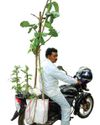Mother Teresa's blue and white sari has been trademarked so that it is not misused. But to what end?

NEARLY 70 years ago, a nun who left the seclusion of her convent to work among the poorest and most destitute of Indians, shed her traditional habit to wear something more in keeping with the spirit of her new assignment. The nun, who would in due course become known worldwide as the Mother Teresa for her compassion, also made famous the traditional Bengali sari she chose as the habit of her order, the Missionaries of Charity (MOC).
Mother Teresa was a professed Loreto Convent nun when she opted in 1948 to leave its cloisters and work outside with the poor. She also opted to wear the local sari in her new avatar. She chose a traditional Bengali sari she found on Harrison Road in Kolkata (Calcutta then). The simplest of these are white saris with three coloured stripes on the border, one larger than the other two, which come in red, blue and white. Mother Teresa chose the blue-striped saris and since then, these have become the habit of the MOC but are most famously identified with her.
Bu hikaye Down To Earth dergisinin August 16, 2017 sayısından alınmıştır.
Start your 7-day Magzter GOLD free trial to access thousands of curated premium stories, and 9,000+ magazines and newspapers.
Already a subscriber ? Giriş Yap
Bu hikaye Down To Earth dergisinin August 16, 2017 sayısından alınmıştır.
Start your 7-day Magzter GOLD free trial to access thousands of curated premium stories, and 9,000+ magazines and newspapers.
Already a subscriber? Giriş Yap

In leading role again
MOVIES AND WEB SERIES ARE ONCE AGAIN BEING SET IN RUSTIC BACKGROUNDS, INDICATING A RECONNECT BETWEEN CINEMA AND THE COUNTRYSIDE

One Nation One Subscription comes at a huge cost
As top US universities scrap big deals with top scientific publishers, India’s ONOS scheme seems flawed and outdated

Return of Rambhog
Bid to revive and sell the aromatic indigenous paddy variety has led to substantial profits for farmers in Uttar Pradesh's Terai region

Scarred by mining
Natural springs of Kashmir drying up due to illegal riverbed mining

Human-to-human spread a mutation away
CANADA IN mid-November confirmed its first human case of avian influenza, with a teenager in the British Columbia being hospitalised after contracting the H5N1 virus that causes the disease. The patient developed a severe form of the disease, also called bird flu, and had respiratory issues. There was no known cause of transmission.

True rehabilitation
Residents of Madhya Pradesh's Kakdi village take relocation as an opportunity to undertake afforestation, develop sustainable practices

INESCAPABLE THREAT
Chemical pollution is the most underrated and underreported risk of the 21st century that threatens all species and regions

THAT NIGHT, 40 YEARS AGO
Bhopal gas disaster is a tragedy that people continue to face

A JOKE, INDEED
A CONFERENCE OF IRRESPONSIBLE PARTIES THAT CREATED AN OPTICAL ILLUSION TO THE REALITY OF A NEW CLIMATE

THINGS FALL APART
THE WORLD HAS MADE PROGRESS IN MITIGATING EMISSIONS AND ADAPTING TO CLIMATE IMPACTS. BUT THE PROGRESS REMAINS GROSSLY INADEQUATE